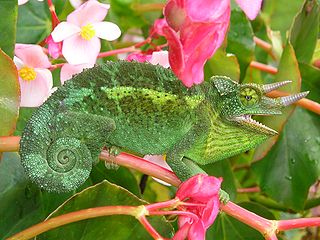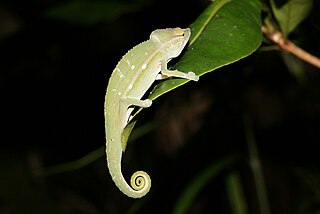
Chameleons or chamaeleons are a distinctive and highly specialized clade of Old World lizards with 200 species described as of June 2015. The members of this family are best known for their distinct range of colors, being capable of shifting to different hues and degrees of brightness. The large number of species in the family exhibit considerable variability in their capacity to change color. For some, it is more of a shift of brightness ; for others, a plethora of color-combinations can be seen.

Bradypodion is a genus of chameleons in the family Chamaeleonidae, collectively called South African dwarf chameleons. All species are found in South Africa and most are endemic to this country, but a few can also be found in Eswatini, Lesotho, southernmost Namibia and possibly southernmost Mozambique. They are quite small chameleons where the different species often can be difficult to separate by appearance, although exact location and the intense breeding colours of males are useful for their identification. They are arboreal, but some species are mostly found low in the vegetation.

Jackson's chameleon, also known as Jackson's horned chameleon, three-horned chameleon or Kikuyu three-horned chameleon, is a species of chameleon native to East Africa, and introduced to Hawaii, Florida, and California.

The Indian chameleon is a species of chameleon found in Sri Lanka, India, Pakistan and select other parts of South Asia. Like other chameleons, this species moves slowly with a bobbing or swaying movement and are usually arboreal. They have an extremely long and sticky tongue, which they use to catch insects from several feet away. Also like other chameleons, C. zeylanicus has bifurcated feet with a tongs-like shape, a prehensile tail, independent eye movement, and the ability to rapidly change skin colouring and patterns. Despite common misconceptions, they do not change their visual appearance based on their surroundings or background, or even for camouflage, and may not even be able to perceive colour differences; rather, it is primarily for communication with others of their species, including to signify the receptiveness of a female or submissiveness in general disputes. Additionally, colouring can change for controlling body temperature, changing to darker colours to absorb heat, or lighter to cool themselves.

Opheodrys is a genus of small to medium-sized nonvenomous colubrid snakes commonly referred to as green snakes. In North America the genus consists of two distinct species. As their common names imply, the rough green snake has keeled dorsal scales, whereas the smooth green snake has smooth dorsal scales.

Kinyongia is a genus of chameleons found in montane and sub-montane areas in Kenya, Tanzania, Uganda, Rwanda, Burundi, and far eastern DR Congo. They are restricted to forests, woodlands and other wooded habitats, and many species have very small geographic ranges. In most species, at least the males have horns or knobs on their noses. As typical of most chameleons, Kinyongia are oviparous.

Rieppeleon is a genus of small, typically brown chameleons found in forests and savannas in central East Africa. They are found at low levels in bushes, or on the ground among grass or leaf litter.

Trioceros is a genus of lizards in the family Chamaeleonidae, the chameleons, native to lowlands and highlands in the African mainland, ranging from Ethiopia south to Mozambique and west as far as Ghana. Trioceros was considered a subgenus of the genus Chamaeleo until 2009, when it was elevated to full genus level.

Trioceros melleri, with the common names Meller's chameleon and giant one-horned chameleon, is the largest species of chameleon from the African mainland.

The flap-necked chameleon is a species of arboreal chameleon, a lizard in the family Chamaeleonidae. The species is native to sub-Saharan Africa. There are eight recognized subspecies, including the nominotypical subspecies.
Kinyongia carpenteri, commonly called Carpenter's chameleon or the helmeted chameleon, is a species of chameleon, a lizard in the family Chamaeleonidae. The species is native to central Africa.

Chamaeleoninae is the nominotypical subfamily of chameleons. The Family Chamaeleonidae was divided into two subfamilies, Brookesiinae and Chamaeleoninae, by Klaver and Böhme in 1986. Since its erection in 1986, however, the validity of this subfamily designation has been the subject of much debate, although most phylogenetic studies support the notion that the pygmy chameleons of the subfamily Brookesiinae are not a monophyletic group. While some authorities have previously preferred to use the subfamilial classification on the basis of the absence of evidence principal, these authorities later abandoned this subfamilial division, no longer recognizing any subfamilies with the family Chamaeleonidae. In 2015, however, Glaw reworked the subfamilial division by placing only the genera Brookesia and Palleon within the Brookesiinae subfamily, with all other genera being placed in Chamaeleoninae.

Owen's chameleon, also commonly known as Owen's three-horned chameleon, is a species of lizard in the family Chamaeleonidae. The species is native to forests in central Africa. Named after British naval officer and explorer William Fitzwilliam Owen, it was first described in 1831 by the naturalist John Edward Gray, and is the type species of the genus Trioceros.

Kinyongia uthmoelleri, known commonly as the Hanang hornless chameleon, Müller's leaf chameleon, and Uthmöller's chameleon, is species of lizard in the family Chamaeleonidae. The species is endemic to Tanzania.

The four-horned chameleon is a species of chameleon, a lizard in the family Chamaeleonidae. The species is native to highland areas in western Cameroon and southeastern Nigeria.
Trioceros chapini, also known commonly as Chapin's chameleon, the gray chameleon, and the grey chameleon, is a species of lizard in the family Chamaeleonidae. The species is native to Central Africa.

Trioceros ellioti, also known commonly as Elliot's chameleon, Elliot's groove-throated chameleon, and the montane side-striped chameleon, is a species of lizard in the family Chamaeleonidae. The species is indigenous to Africa.
Trioceros feae, also known commonly as the Bioko montane chameleon and Fea's chameleon, is a species of lizard in the family Chamaeleonidae. The species is endemic to the island of Bioko.
Trioceros fuelleborni, also known commonly as the flapjack chameleon, the Ngosi Volcano chameleon, and the Poroto three-horned chameleon, is a species of lizard in the family Chamaeleonidae. The species is endemic to Tanzania.
Trioceros goetzei, also known commonly as Goetze's chameleon, Goetze's whistling chameleon, and the Ilolo chameleon, is a species of lizard in the family Chamaeleonidae. The species is native to eastern Africa. There are two recognized subspecies.




























